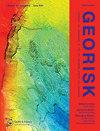使用无监督和有监督的协作机器学习模型改进滑坡易感性映射
IF 4.8
3区 工程技术
Q1 ENGINEERING, GEOLOGICAL
Georisk-Assessment and Management of Risk for Engineered Systems and Geohazards
Pub Date : 2022-06-19
DOI:10.1080/17499518.2022.2088802
引用次数: 11
摘要
包含记录的滑坡和非滑坡样本的数据集可以极大地影响机器学习(ML)模型的性能,机器学习(ML)模型通常用于滑坡敏感性制图(LSM)。而非滑坡样不能直接获得。在本研究中,提出了一种基于模式的方法来改进LSM过程,构建无监督机器学习(UML) -监督机器学习(SML)协作模型,该模型可以合理选择非滑坡样本。引入高斯混合模型(GMM)和K-means两种UML模型,对四种抽样选择(分别缩写为A、B、C和D)的非滑坡数据集进行抽样。然后由UML模型识别的非滑坡模式由随机森林(RF)学习。定义了一个新的灵敏度指标——准确度改进比(AIR)来评价这些采样选择的优越性。与GMM-RF模型相比,K-means-RF模型对非滑坡模式的识别能力更强,能够提供充足、可靠的非滑坡样本。将AIR值为2.3的K-means-RF的抽样选择A视为最佳选择。结果表明,基于模式方法的UML-SML模型为寻找非滑坡样本提供了一种有效的策略,能够较好地解决LSM问题。本文章由计算机程序翻译,如有差异,请以英文原文为准。
Improved landslide susceptibility mapping using unsupervised and supervised collaborative machine learning models
ABSTRACT Datasets containing recorded landslide and non-landslide samples can greatly influence the performance of machine learning (ML) models, which are commonly used in landslide susceptibility mapping (LSM). However, the non-landslide samples cannot be directly obtained. In this study, a pattern-based approach is proposed to improve the LSM process, constructing unsupervised machine learning (UML) – supervised machine learning (SML) collaborative models in which the non-landslide samples can be reasonably selected. Two UML models, the Gaussian mixture model (GMM) and K-means, are introduced to sample the non-landslide datasets with four sampling selections (abbreviated as A, B, C and D, respectively). Then non-landslide patterns recognised by the UML models are learned by the random forest (RF). A new sensitivity index, accuracy improvement ratio (AIR), is defined to evaluate the superiority of these sampling selections. Compared with the GMM-RF model, the K-means-RF model is more capable of recognising non-landslide patterns and providing sufficient and reliable non-landslide samples. The sampling selection A of the K-means-RF with an AIR value of 2.3 is regarded as the best selection. The results indicate that the UML-SML model based on the pattern-based approach offers an effective strategy to find the non-landslide samples and has a better solution to the LSM.
求助全文
通过发布文献求助,成功后即可免费获取论文全文。
去求助
来源期刊
CiteScore
8.70
自引率
10.40%
发文量
31
期刊介绍:
Georisk covers many diversified but interlinked areas of active research and practice, such as geohazards (earthquakes, landslides, avalanches, rockfalls, tsunamis, etc.), safety of engineered systems (dams, buildings, offshore structures, lifelines, etc.), environmental risk, seismic risk, reliability-based design and code calibration, geostatistics, decision analyses, structural reliability, maintenance and life cycle performance, risk and vulnerability, hazard mapping, loss assessment (economic, social, environmental, etc.), GIS databases, remote sensing, and many other related disciplines. The underlying theme is that uncertainties associated with geomaterials (soils, rocks), geologic processes, and possible subsequent treatments, are usually large and complex and these uncertainties play an indispensable role in the risk assessment and management of engineered and natural systems. Significant theoretical and practical challenges remain on quantifying these uncertainties and developing defensible risk management methodologies that are acceptable to decision makers and stakeholders. Many opportunities to leverage on the rapid advancement in Bayesian analysis, machine learning, artificial intelligence, and other data-driven methods also exist, which can greatly enhance our decision-making abilities. The basic goal of this international peer-reviewed journal is to provide a multi-disciplinary scientific forum for cross fertilization of ideas between interested parties working on various aspects of georisk to advance the state-of-the-art and the state-of-the-practice.

 求助内容:
求助内容: 应助结果提醒方式:
应助结果提醒方式:


